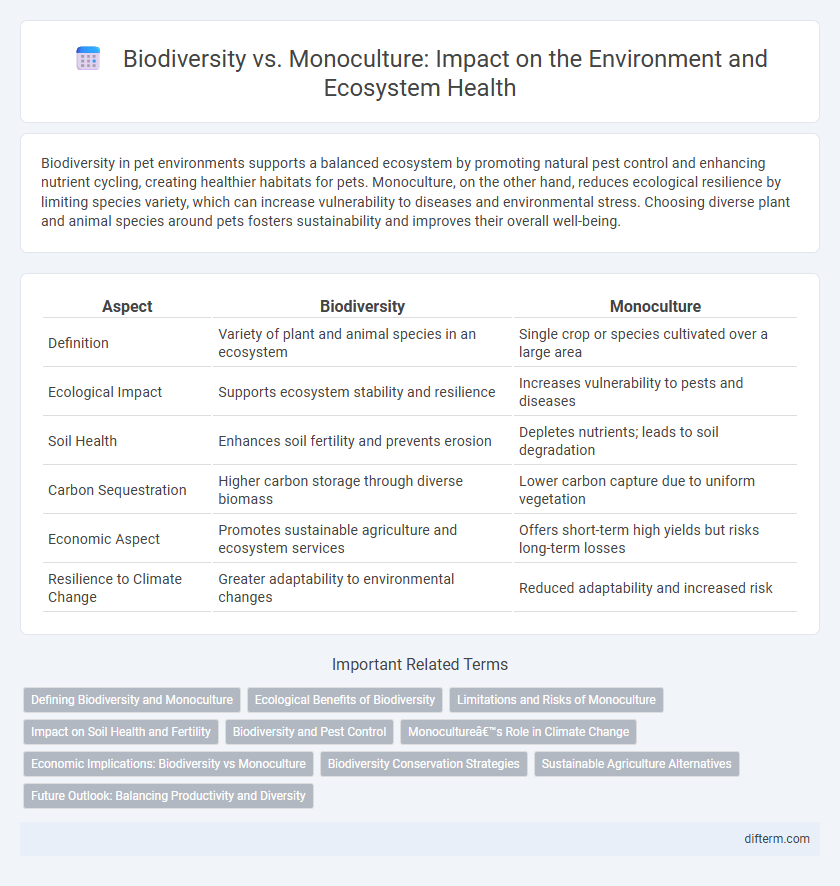Biodiversity in pet environments supports a balanced ecosystem by promoting natural pest control and enhancing nutrient cycling, creating healthier habitats for pets. Monoculture, on the other hand, reduces ecological resilience by limiting species variety, which can increase vulnerability to diseases and environmental stress. Choosing diverse plant and animal species around pets fosters sustainability and improves their overall well-being.
Table of Comparison
| Aspect | Biodiversity | Monoculture |
|---|---|---|
| Definition | Variety of plant and animal species in an ecosystem | Single crop or species cultivated over a large area |
| Ecological Impact | Supports ecosystem stability and resilience | Increases vulnerability to pests and diseases |
| Soil Health | Enhances soil fertility and prevents erosion | Depletes nutrients; leads to soil degradation |
| Carbon Sequestration | Higher carbon storage through diverse biomass | Lower carbon capture due to uniform vegetation |
| Economic Aspect | Promotes sustainable agriculture and ecosystem services | Offers short-term high yields but risks long-term losses |
| Resilience to Climate Change | Greater adaptability to environmental changes | Reduced adaptability and increased risk |
Defining Biodiversity and Monoculture
Biodiversity refers to the variety of life forms within a given ecosystem, encompassing different species, genetic variations, and ecological processes that support resilience and sustainability. In contrast, monoculture involves the cultivation of a single crop species over a large area, often leading to reduced genetic diversity and increased vulnerability to pests and diseases. Maintaining biodiversity enhances ecosystem stability, while monoculture practices can undermine soil health and environmental balance.
Ecological Benefits of Biodiversity
Biodiversity enhances ecosystem resilience by supporting a wide range of species that contribute to nutrient cycling, soil fertility, and natural pest control, reducing dependency on chemical inputs. Diverse ecosystems improve water regulation and carbon sequestration, mitigating the impacts of climate change more effectively than monocultures. Compared to monoculture systems, which often lead to soil degradation and increased vulnerability to pests and diseases, biodiversity promotes ecological stability and sustainable productivity.
Limitations and Risks of Monoculture
Monoculture agriculture significantly reduces biodiversity by cultivating a single crop species over large areas, which leads to habitat loss and disrupts ecosystem balance. This practice increases vulnerability to pests and diseases, often necessitating heavy pesticide use that harms soil health and non-target species. The lack of genetic diversity in monocultures also diminishes resilience against climate change, making food systems more prone to failure.
Impact on Soil Health and Fertility
Biodiversity enhances soil health by supporting a wide range of microorganisms that improve nutrient cycling and organic matter decomposition, leading to increased soil fertility and structure. In contrast, monoculture practices often deplete essential nutrients, reduce microbial diversity, and increase soil erosion, resulting in diminished soil quality over time. Integrating diverse plant species in agricultural systems promotes resilience against pests and diseases while maintaining long-term soil productivity.
Biodiversity and Pest Control
Biodiversity plays a crucial role in natural pest control by fostering a balanced ecosystem where predators and beneficial insects regulate pest populations. Diverse plant species create habitats that support a wide range of organisms, reducing reliance on chemical pesticides and enhancing crop resilience. Monoculture systems lack this biological complexity, often leading to increased pest outbreaks and greater vulnerability to disease.
Monoculture’s Role in Climate Change
Monoculture farming significantly contributes to climate change by reducing biodiversity, which weakens ecosystems' resilience to environmental stressors. The extensive use of single crop species depletes soil nutrients, leading to increased reliance on chemical fertilizers that emit greenhouse gases like nitrous oxide. Loss of diverse plant life also diminishes carbon sequestration capacity, accelerating global warming trends.
Economic Implications: Biodiversity vs Monoculture
Biodiversity supports resilient ecosystems that enhance agricultural productivity and reduce vulnerability to pests and diseases, leading to stable long-term economic benefits. In contrast, monoculture often yields higher short-term profits but increases risks of crop failure and soil degradation, resulting in costly economic losses. Investing in biodiversity-driven farming practices promotes sustainable income streams and lowers dependency on chemical inputs, positively impacting overall economic stability.
Biodiversity Conservation Strategies
Biodiversity conservation strategies prioritize preserving multiple species and ecosystems to maintain ecological balance and resilience. Techniques such as habitat restoration, protected areas establishment, and sustainable land management counteract the risks posed by monoculture farming, which reduces genetic diversity and increases vulnerability to pests and diseases. Emphasizing native species conservation and promoting agroforestry integrates biodiversity into agricultural landscapes, enhancing ecosystem services and long-term productivity.
Sustainable Agriculture Alternatives
Biodiversity-rich farming systems enhance ecosystem resilience by supporting a variety of plant and animal species, which improve soil health and pest control naturally. Monoculture practices, often reliant on chemical inputs, degrade soil quality and increase vulnerability to pests and diseases. Sustainable agriculture alternatives like agroforestry, crop rotation, and polycultures promote long-term productivity while conserving biodiversity and reducing environmental impact.
Future Outlook: Balancing Productivity and Diversity
Future agricultural sustainability hinges on integrating biodiversity within monoculture systems to enhance ecosystem resilience and yield stability. Diverse crop rotations and agroforestry practices promote soil health, pest resistance, and climate adaptability, ensuring long-term productivity. Innovations in biotechnologies and precision farming enable optimized resource use while maintaining genetic diversity crucial for environmental balance.
biodiversity vs monoculture Infographic

 difterm.com
difterm.com